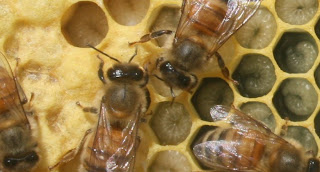Beef Wellington
This months host is Mz Kitchen of Madame Chow's Kitchen. (The pictures through out this post are from Lori of Lori's Lipsmacking Goodness and Temperance of High on the Hog.) She is helping us launch our new website and celebrate our 1 yr Aniversary with this great recipe!
According to wikipedia, Beef Wellington "is a preparation of beef tenderloin coated with pâté (often pâté de foie gras) and duxelles, which is then wrapped in puff pastry and baked."
After doing quite a bit of research and experimentation, I put this recipe together. It's based on the Ultimate Beef Wellington by Tyler Florence, but I added a couple things and eliminated a couple others.
What is required: using the puff pastry (I've heard that there are vegan versions on the market, but I haven't found them), a protein, and the duxelles. You don't have to use beef, you can use chicken, or fish. If you're a vegetarian (I was a strict one for over 20 years), I recommend that you use tempeh or seitan as your protein. Why? Because moisture is the enemy here! Even pressed tofu will be too moist, and you will end up with extremely soggy pastry. Ultimately, though, it's up to you what protein you choose for the dish.
Cook the duxelles on low heat so that you have a chance to evaporate the liquid, but so that you don't burn the mushrooms and shallots. If you like your meat rare or medium rare, I suggest keeping the seared beef in the refrigerator until just before you put everything together - it took so long to brown my puff pastry, that the beef was well done. Fortunately, my husband said it was still moist, but using cold beef means that it will take longer to cook, giving your puff pastry the time to brown.
Here is a helpful Gordon Ramsey video. Please note that the recipe below does NOT include the ham that Ramsey is using in the video, but if you like the idea, go for it and use it! You can also make individual servings, but remember that you will have to adjust the cooking time accordingly - try 20 to 25 minutes to start, but be sure to check because cooking time will vary because of the thickness of the meat, the type of meat you are using, your brand of puff pastry, and your oven.
Beef Wellington
For the Duxelles:
For the Beef:
Directions
To make the Duxelles:
Add mushrooms, shallots, garlic, and thyme to a food processor and pulse until finely chopped. Add butter and olive oil to a large saute pan and set over medium heat. Add the shallot and mushroom mixture and saute for 8 to 10 minutes until most of the liquid has evaporated. Season with salt and pepper and set aside to cool completely.
To prepare the beef:
Tie the tenderloin in 4 places so it holds its cylindrical shape while cooking. Drizzle with olive oil, then season with salt and pepper and sear all over, including the ends, in a hot, heavy-based skillet lightly coated with olive oil - about 2 to 3 minutes.
Using a rubber spatula cover evenly with a thin layer of duxelles. Season the surface of the duxelles with salt and pepper and sprinkle with fresh thyme leaves. When the beef is seared, remove from heat, cut off twine and smear lightly all over with Dijon mustard. Allow to cool completely.
I made the duxelles and seared the tenderloin about 10 hours in advance, and refrigerated both of them. It is important that these items are cold because you will be working with puff pastry, and if they're warm, they may cause the dough to melt before you get it in the oven.
About an hour before you plan to serve the Beef Wellington,preheat oven to 425 degrees F.
On a lightly floured surface, roll the puff pastry out to about a 1/4-inch thickness. Depending on the size of your sheets you may have to overlap 2 sheets and press them together.
Spread the duxelles mixture down in a column down the middle of the rolled out puff pastry. Thinly slice the mousse and cover the duxelles with it - every square millimeter doesn't have to be covered, but you're trying to make sure that every serving gets beef, duxelle, and mousse.
Remove beef from refrigerator. Set the beef in the center of the pastry and brush all the edges of the pastry with egg wash. Fold the longer sides over the beef, and seal. Trim ends if necessary then brush with egg wash and fold over to completely seal the beef - saving ends to use as a decoration on top if desired. Place the beef seam side down on a baking sheet.
Brush the top of the pastry with egg wash then make a couple of slits in the top of the pastry using the tip of a paring knife - this creates vents that will allow the steam to escape when cooking. Bake for 40 to 45 minutes until pastry is golden brown and beef registers 125 degrees F (rare) on an instant-read thermometer. Remove from oven and rest before cutting into 3/4-inch thick slices
From the Forums:
According to wikipedia, Beef Wellington "is a preparation of beef tenderloin coated with pâté (often pâté de foie gras) and duxelles, which is then wrapped in puff pastry and baked."
After doing quite a bit of research and experimentation, I put this recipe together. It's based on the Ultimate Beef Wellington by Tyler Florence, but I added a couple things and eliminated a couple others.
What is required: using the puff pastry (I've heard that there are vegan versions on the market, but I haven't found them), a protein, and the duxelles. You don't have to use beef, you can use chicken, or fish. If you're a vegetarian (I was a strict one for over 20 years), I recommend that you use tempeh or seitan as your protein. Why? Because moisture is the enemy here! Even pressed tofu will be too moist, and you will end up with extremely soggy pastry. Ultimately, though, it's up to you what protein you choose for the dish.
Cook the duxelles on low heat so that you have a chance to evaporate the liquid, but so that you don't burn the mushrooms and shallots. If you like your meat rare or medium rare, I suggest keeping the seared beef in the refrigerator until just before you put everything together - it took so long to brown my puff pastry, that the beef was well done. Fortunately, my husband said it was still moist, but using cold beef means that it will take longer to cook, giving your puff pastry the time to brown.
Here is a helpful Gordon Ramsey video. Please note that the recipe below does NOT include the ham that Ramsey is using in the video, but if you like the idea, go for it and use it! You can also make individual servings, but remember that you will have to adjust the cooking time accordingly - try 20 to 25 minutes to start, but be sure to check because cooking time will vary because of the thickness of the meat, the type of meat you are using, your brand of puff pastry, and your oven.
Beef Wellington
For the Duxelles:
3 pints (1 1/2 pounds) white button mushrooms
2 shallots, peeled and roughly chopped
4 cloves garlic, peeled and roughly chopped
2 sprigs fresh thyme, leaves only
2 tablespoons unsalted butter
2 tablespoons extra-virgin olive oil
Kosher salt and freshly ground black pepper
For the Beef:
1 (3-pound) center cut beef tenderloin (filet mignon), trimmed
Extra-virgin olive oil
Kosher salt and freshly ground black pepper
6 sprigs of fresh thyme, leaves only
2 tablespoons Dijon mustard
Flour, for rolling out puff pastry
1 pound puff pastry, thawed if using frozen (follow directions on the package)
2 large eggs, lightly beaten
8 ounces mousse pate, available in specialty cheese and appetizer cases of larger markets (optional)
Directions
To make the Duxelles:
Add mushrooms, shallots, garlic, and thyme to a food processor and pulse until finely chopped. Add butter and olive oil to a large saute pan and set over medium heat. Add the shallot and mushroom mixture and saute for 8 to 10 minutes until most of the liquid has evaporated. Season with salt and pepper and set aside to cool completely.
To prepare the beef:
Tie the tenderloin in 4 places so it holds its cylindrical shape while cooking. Drizzle with olive oil, then season with salt and pepper and sear all over, including the ends, in a hot, heavy-based skillet lightly coated with olive oil - about 2 to 3 minutes.
Using a rubber spatula cover evenly with a thin layer of duxelles. Season the surface of the duxelles with salt and pepper and sprinkle with fresh thyme leaves. When the beef is seared, remove from heat, cut off twine and smear lightly all over with Dijon mustard. Allow to cool completely.
I made the duxelles and seared the tenderloin about 10 hours in advance, and refrigerated both of them. It is important that these items are cold because you will be working with puff pastry, and if they're warm, they may cause the dough to melt before you get it in the oven.
About an hour before you plan to serve the Beef Wellington,preheat oven to 425 degrees F.
On a lightly floured surface, roll the puff pastry out to about a 1/4-inch thickness. Depending on the size of your sheets you may have to overlap 2 sheets and press them together.
Spread the duxelles mixture down in a column down the middle of the rolled out puff pastry. Thinly slice the mousse and cover the duxelles with it - every square millimeter doesn't have to be covered, but you're trying to make sure that every serving gets beef, duxelle, and mousse.
Remove beef from refrigerator. Set the beef in the center of the pastry and brush all the edges of the pastry with egg wash. Fold the longer sides over the beef, and seal. Trim ends if necessary then brush with egg wash and fold over to completely seal the beef - saving ends to use as a decoration on top if desired. Place the beef seam side down on a baking sheet.
Brush the top of the pastry with egg wash then make a couple of slits in the top of the pastry using the tip of a paring knife - this creates vents that will allow the steam to escape when cooking. Bake for 40 to 45 minutes until pastry is golden brown and beef registers 125 degrees F (rare) on an instant-read thermometer. Remove from oven and rest before cutting into 3/4-inch thick slices
From the Forums:
It was like the most succulent bite of beef with all the layers of flavor. I am not a big beef fan either. So for me to say this- it means a lot. Lori of Lori's Lipsmacking Goodness
I made this for my husband using a truffle mousse from Whole Foods, and he LOVED it. At first he wasn't sure, but then changed his opinion as he made his way through the dish. Mz Kitchen of Madame Chow's Kitchen

![Reblog this post [with Zemanta]](http://img.zemanta.com/reblog_c.png?x-id=9aea91ca-d5ff-4898-b333-8c4fd964a1db)














![Reblog this post [with Zemanta]](http://img.zemanta.com/reblog_c.png?x-id=b43901fe-7a57-4830-8cd2-c992fb90cd9b)



























.jpg)





0 comments:
welcome to my blog. please write some comment about this article ^_^